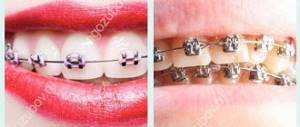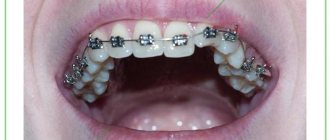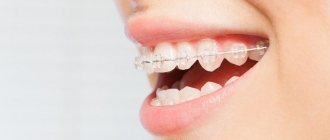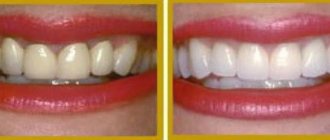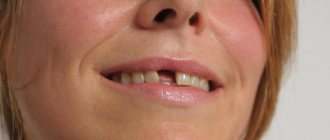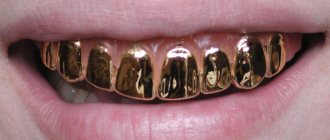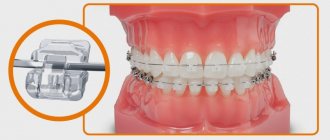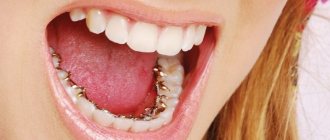White wire braces: myths and facts
Many dental fields are surrounded by myths and misconceptions, and white braces are no exception. So, there is a myth that the arc is cast from light-colored metal. In fact, alloys of nickel, steel, titanium, etc. are used for this, and the light shade is obtained through the use of Teflon. It is quite resistant to external influences, although it can peel off due to such irritants. Another thing is that the frequency of changing arches, which is from 1 to 3 months, will not allow Teflon to lose its qualities, of course, provided that proper care of the system and oral hygiene is taken care of.
White braces cannot be called completely invisible; they will still stand out against the background of the dentition, but they are much less noticeable than metal ones. It is worth saying that a certain percentage of patients, on the contrary, consider it stylish and are happy to give preference to metal structures.
Duration of therapy and effectiveness
The duration of wearing braces may vary depending on the severity of the crooked teeth. On average, treatment takes 18 months, but for some, a year is enough. The metal from which the braces are made does not matter, and this does not affect the wearing period.
Treatment usually lasts from one to one and a half years
You can enjoy the first results in three months. Despite the improvement, no one will allow you to remove your braces. Early withdrawal is fraught with bad consequences. The position of the teeth may return to their previous state, and you will have to start all over again.
Rules for caring for teeth with braces
White arches, clasps and elastic bands
For most people, braces are associated only with bulky, monstrous structures, and many are not even aware of the existence of white braces. They can be made of plastic, sapphire or ceramic, and their main difference will be aesthetics, that is, they are practically invisible in the mouth and do not cause any psychological discomfort to the patient.
White braces do not have a specific name; they are usually called simply white arches, since they become the main component of the entire structure. Its elastic bands and clasps are also usually white, therefore, in addition to the traditional task of straightening teeth, using this system you can also hide the fact of wearing braces from prying eyes.
Initially, they were made of plastic and differ favorably from metal structures precisely because of their aesthetics, but the downside was their fragility and low strength. Over time, the paint on the system wore off, chips appeared and the color changed, so ceramic and sapphire designs also began to appear, replacing plastic ones.
Plastic, ceramic or artificial sapphire?
The most affordable are plastic braces that blend with the teeth. Their clasps are made of dental plastic, selected to match the natural shade of the patient’s tooth enamel. They have a metal groove in which the orthodontic arch slides with minimal friction, due to which the teeth are aligned quite quickly.
But such braces have several significant disadvantages. Due to the low strength of plastic, they quickly wear out and chip and easily change the chosen shade under the influence of artificial and natural dyes contained in drinks and foods.
They were replaced by even less noticeable, but more expensive and therefore installed in installments ceramic braces. They are divided into two subgroups, look approximately the same, differing in appearance only in the degree of transparency, and in color they turn out to be completely identical to tooth enamel.
- The first subgroup includes braces with clasps made of matte, partially opaque polycrystalline ceramics. Dentists call them ceramic braces.
- The second category includes the best aesthetic braces made from transparent ceramic single crystals. These are the most invisible and most expensive systems that ideally mask the treatment process and thus fully justify the financial costs.
Disadvantages of white braces
As for the shortcomings, there are also them, which is quite natural; speaking specifically, these should include:
- an attractive appearance is possible only on white teeth;
- longer period of adaptation of the patient to the system due to its size;
- in comparison with metal structures, they are less reliable in terms of strength;
- they are more demanding to care for in terms of their fragility.
One of the most significant arguments “against” white systems is their price; for a considerable number of patients this aspect is of decisive importance.
What types of white braces are there?
Today, plastic structures are not found very often, giving way to ceramics and sapphires. Ceramic systems are found in two versions: monocrystalline and polycrystalline. The former have a matte tint, while the latter almost completely merge with the teeth due to their transparency. With their help, you can set and successfully solve the problem of correcting the bite, as well as get rid of the patient’s psychological problems.
Ceramic products - the golden mean
Another good thing about ceramics is that you can eat your favorite food almost without exception, and also not have to worry about poor diction. The disadvantage will be the need for careful maintenance, but this is perhaps the only serious disadvantage of such structures.
Often ceramic systems are produced with a white arc. They adhere well to the enamel, are transparent and almost invisible, but the price for them starts at about 50 thousand rubles.
You can find out more about ceramic braces here.
Sapphire designs - elite option
Sapphire systems are made from artificial crystals specially grown for this purpose. They are distinguished by a high level of strength, look very beautiful and are almost invisible to others, but are significantly more expensive than ceramic systems.
Note: It is best to place white braces on the upper row of teeth, since they are more noticeable when talking and smiling. To achieve an even higher level of aesthetics, many dentists recommend installing systems with wings that will protect the structure from food particles getting into it.
The duration of treatment with sapphire systems is about two years; in other respects there are no differences from ceramics, but this does not concern the cost. The difference between sapphires and ceramics is approximately twofold; the price for such designs can reach 100 thousand.
Full information about sapphire white braces can be found here.
Plastic systems - a budget solution
There are no external differences between plastic braces and ceramic or sapphire analogues; it is easy to choose the color to match the desired shade; in addition, you can further improve aesthetic indicators with the help of a white arch. Finally, the financial aspect plays a decisive role, since this is the cheapest option of all those discussed above, but there are also disadvantages that push many people to choose sapphire or ceramic designs:
- not the highest strength, which, of course, can be strengthened with additional materials, but this will immediately lead to an increase in the cost of the system;
- poor color fastness, which means avoiding some products, especially those containing dyes;
- longer duration of treatment due to slow movement of teeth in a row.
You can find out more about plastic white systems in this article.
How to care for braces?
Don't forget that when wearing braces, your teeth still need care as much as before. Failure to comply with oral hygiene rules can lead to the development of caries, which is extremely undesirable. The doctor, seeing caries, may stop treatment and force the braces to be removed without waiting for a complete cure.
In order not to damage the braces, it is better to eat non-solid food. Gnawing on nuts, bagels, and sweets is strictly prohibited. It is also better to avoid chewing gum. You should not take risks and experiment with the strength of your braces system.
Avoid chewing gum while wearing braces
Hot or very cold food can also damage your braces. They may begin to peel off from the teeth.
It should be remembered that ceramics and sapphire in braces react very sensitively to coffee drinks and tobacco. From their excessive use, the surface of the braces can change its snow-white color to yellow. The same applies to strong tea. Red wine lovers will have to switch to white, although this does not affect the effectiveness of treatment.
Well-known manufacturers, in order not to lose face in front of the consumer, carefully test their product for resistance to color changes. Only cheap and low-quality braces change color.
Important! It should be taken into account that caring for teeth with ceramic braces is much more difficult and the process of cleaning “ceramics” takes much longer.
Teeth with ceramics must be brushed every time after eating.
Teeth with ceramic braces will have to be brushed after meals every time instead of the usual “morning and evening”. You will have to purchase a special orthodontic toothbrush at the store. It perfectly cleans the space between the tooth surface and arches. At the final stage of brushing your teeth, you need to use special dental floss.
Differences between white arcs and metal ones
The arch is the part of the orthodontic structure that receives the closest attention. This state of affairs is explained by the fact that its role in correcting the bite cannot be overestimated; in particular, it is the arch that creates the necessary pressure, due to which the teeth move in the desired direction.
From the point of view of its characteristics, a white arc is no different from a metal one; the main role here is played by external differences. In fact, it is also made of metal, but covered on top with enamel with a special composition, thanks to which it is not so striking to others. Color does not have any effect on the effectiveness of the treatment process.
Features of wearing and care of the system
White braces can be an excellent solution for those who may have psychological discomfort from wearing such braces. For example, many children experience stress from ordinary metal structures because they are teased by their peers, and to make it easier to endure this period, it makes sense to consider installing just such a structure.
Some patients complain that the white color changes to yellow over time, blaming the imperfection of the design and their dentist for this. However, the fact is that such a picture arises in situations where patients do not take good care of their oral hygiene and skip visits to the doctor for correction. Accordingly, a proper attitude to these issues will allow you not to encounter this problem while wearing the system.
Which white braces should you choose?
Today there are many different models on the market, but the most common and popular are:
- Clarity - durable and reliable braces with a matte finish, the base is a metal groove;
- Mystique GAC - made entirely of ceramic without any metal inserts;
- Reflections is a ligature ceramic system, a distinctive feature is the high effectiveness of treatment;
- Damon clear - has a small size, and most importantly, is one of the lingual systems; the manufacturing material is ceramics;
- LUXI II Keramik - a design with high efficiency indicators, characterized by the use of gold plating for the grooves;
- In Ovation is a lingual system characterized by excellent reliability of fixation on the patient’s teeth;
- QuicKlear is another option that offers excellent and secure hold, which is achieved through the use of special protrusions in the hook-shaped design.
Features of using MTD MEAW
The benefits of treatment with MEAW IVD are as follows:
- The position and direction of each tooth is controlled. With the help of the IVD, the jaw and its bone components are directed to a position that is strictly defined. Violations and errors are completely excluded.
- The closure between the teeth is completely restored. In this case, the occlusal plane indicator does not matter. Treatment occurs at any value.
- Getting a stable result. The design affects the patient’s jaw and teeth gently but regularly, which is an important factor.
- The time for bite treatment is reduced. This is ensured by the fact that at certain moments the leveling force of the system can be increased.
- Reducing the load on the dentition. Although the impact on the teeth is mild, it occurs constantly. This facilitates the adaptation process and eliminates the feeling of discomfort during treatment.
It should be noted that the impact force of the MEAW IVD effectively aligns the bite, introducing abnormally protruding units into the dentition.
Cost of installing white braces
The price is largely determined by the model of a particular system. For example, lingual systems will cost significantly more than ligature ones, but you will have to visit the dentist for correction, and, accordingly, you will have to pay for it less often (once a month versus three).
Factors such as the complexity of the treatment, the current state of health of the patient, the level of oral hygiene, and so on also play a role in pricing. It is worth remembering that before installing the system, it is necessary to cure all dental diseases, possibly removing wisdom teeth.
The approximate cost is calculated as follows:
- consultation and diagnostics - from 1,000 to 2,500 rubles (in some clinics the initial consultation is free);
- installation of a bracket system - from 100 to 150 thousand (for both jaws);
- design correction - about 1 thousand per visit;
- removing braces, cleaning teeth, installing retainers - approximately 5-6 thousand.
How to remove braces?
You won’t be able to remove braces yourself: this requires special tools. Preparation for the procedure should begin in advance. It needs to be professionally cleaned within a few days. When removing, the doctor uses a polishing bur, carefully removing any remaining adhesive from the surface of the teeth. However, after being freed from braces, it is not always the same color: sometimes you can find light spots on it. Their appearance is the result of the activity of bacteria that cause caries. This happens due to poor teeth cleaning, since it is not always possible to remove plaque under and around the braces. This leads to demineralization of tooth enamel.
You cannot remove braces yourself - this should only be done by a doctor.
Thanks to modern technologies, this problem can be solved. Some companies have learned to preserve the color of teeth after removing braces using a special transparent glue. At the moment of attachment, it serves as an excellent sealant, spreading evenly and adhering tightly to the surface of the tooth. Thus, it protects the enamel not only under the bracket, but also in the space around it.
After removing braces, another step follows. Retainers are replacing the bracket system.
Retainers are completely invisible to others. They come in two types: removable and non-removable.
The removable retainer is a plastic structure. This cap is completely transparent. You need to wear it for a year, almost without taking it off, and every day, giving your teeth a break from it for only four hours a day. In the second year, there is no need to wear a mouthguard for days. You only need to insert it at night, but do not forget to do it daily.
After braces are removed, the person will need to wear a retainer for a period of time.
A permanent retainer has a metal base that looks like an arch. It is attached to the inside of the teeth.
It is necessary to wear retainers, because if you neglect treatment and refuse them, then everything will go down the drain. The teeth will quickly return to their original state, and the treatment process will have to be repeated from the very beginning.
Reviews
Tatyana, 28 years old
I installed a structure made of sapphires. I was pleased with both the result and the wearing procedure itself. What pleased me most was the fact that although the design is noticeable on the teeth, it looks quite cute and stylish.
Galina, 30 years old
I opted for a ceramic system, but soon realized that it was better to give preference to a sapphire one. The main problem was that the structure became quite dirty and it was simply impossible to wash off traces of dyes.
Victoria, 23 years old
I installed plastic braces despite the admonitions of my doctor and regretted it - they quickly became unusable, looked terrible and eventually broke. Now I’ve listened to the advice and decided on ceramics. The downside is that I have to limit myself in taking certain products, but I don’t even remember the danger of breakage.
Plastic
Plastic models became the first aesthetic brace systems, providing an excellent alternative to flashy metal. Visually, they are very similar to ceramic and sapphire solutions. The undeniable advantages of such devices are as follows:
- a wide palette of available shades, which allows you to easily choose a color that will ideally match the natural shade of your teeth. The presence of a white arc in the kit makes it possible to increase the aesthetic properties of the system to its maximum,
- affordable price: the cost of plastic structures usually does not exceed 40-50 thousand rubles, which is significantly lower than ceramic and sapphire devices.
But plastic orthodontic structures also have many significant disadvantages: they quickly break even under minor mechanical stress, change their original color due to food coloring, and quickly lose their attractiveness. And constant repairs and replacement of structures inevitably leads to an increase in the total cost of the entire treatment.
There are very few brands of plastic braces. The following models can be found on the Russian market: Spirit from Ormco, Avalon from Ortho Technology, and Elan from the German company GAC.
